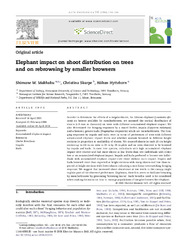| dc.contributor.author | .Makhabu, Shimane W. | |
| dc.contributor.author | Skarpe, Christina | |
| dc.contributor.author | Hytteborn, Håkan | |
| dc.date.accessioned | 2019-03-13T08:09:31Z | |
| dc.date.accessioned | 2021-03-15T09:22:50Z | |
| dc.date.available | 2019-03-13T08:09:31Z | |
| dc.date.available | 2021-03-15T09:22:50Z | |
| dc.date.issued | 2006-10 | |
| dc.identifier.citation | Makhabu, S. W., Skarpe, C., & Hytteborn, H. (2006). Elephant impact on shoot distribution on trees and on rebrowsing by smaller browsers. Acta oecologica, 30(2), 136-146. | en_US |
| dc.identifier.issn | 1873-6238 | |
| dc.identifier.uri | https://www.sciencedirect.com/science/article/pii/S1146609X06000294 | |
| dc.identifier.uri | http://moodle.buan.ac.bw:80/handle/123456789/132 | |
| dc.description | Copyright checked on Sherpa Romeo on 13 March 2019 indicate that author can archive post-print (ie final draft post-refereeing). Author cannot archive publisher's version/PDF. Author's post-print on open access repository after an embargo period of between 12 months and 48 months. Permitted deposit due to Funding Body, Institutional and Governmental policy or mandate, may be required to comply with embargo periods of 12 months to 48 months. Must link to publisher version with DOI. Author's post-print must be released with a Creative Commons Attribution Non-Commercial No Derivatives License | en_US |
| dc.description.abstract | In order to determine the effects of a megaherbivore, the African elephant (Loxodonta africana) on browse available for mesoherbivores, we assessed the vertical distribution of shoots (< 6 mm in diameter) on trees with different accumulated elephant impact. We also determined the foraging responses by a mixed feeder, impala (Aepyceros melampus) and a browser, greater kudu (Tragelaphus strepsiceros) which are mesoherbivores. The foraging responses by impala and kudu were in terms of preferences of trees with different accumulated elephant impact levels and whether animals browsed in different height sections in proportion to availability of shoots. We counted shoots in each 20 cm height section up to 2.6 m on trees in 25 m by 25 m plots and on trees observed to be browsed by impala and kudu. In most tree species, individuals with high accumulated elephant impact were shorter and had more shoots at low levels than tree individuals with either low or no accumulated elephant impact. Impala and kudu preferred to browse tree individuals with accumulated elephant impact over those without such impact. Impala and kudu browsed more than expected at height sections with many shoots and less than expected at height sections with fewer shoots indicating a non-linear overmatching foraging response. We suggest that increased shoot abundance at low levels in the canopy might explain part of the observed preferences. Elephants, therefore, seem to facilitate browsing by mesoherbivores by generating ‘browsing lawns’. Such benefits need to be considered when making decisions on how to manage populations of megaherbivores like elep | en_US |
| dc.language.iso | en | en_US |
| dc.publisher | Elservier | en_US |
| dc.subject | Accumulated elephant impact | en_US |
| dc.subject | Chobe Riverfront | en_US |
| dc.subject | Impala | en_US |
| dc.subject | Kudu | en_US |
| dc.title | Elephant impact on shoot distribution on trees and on rebrowsing by smaller browsers | en_US |
| dc.type | Article | en_US |

